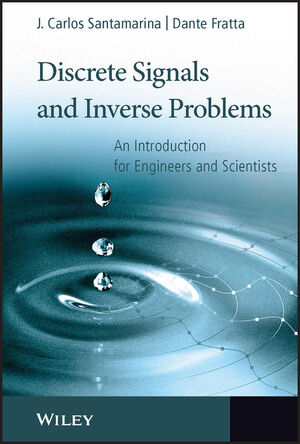Discrete Signals and Inverse Problems: An Introduction for Engineers and ScientistsISBN: 978-0-470-02187-3
Hardcover
304 pages
August 2005
 |
||||||
Brief Comments on Notation.
1. Introduction.
1.1 Signals, Systems, and Problems.
1.2 Signals and Signal Processing -- Application Examples.
1.3 Inverse Problems -- Application Examples.
1.4 History -- Discrete Mathematical Representation.
1.5 Summary.
Solved Problems.
Additional Problems.
2. Mathematical Concepts.
2.1 Complex Numbers and Exponential Functions.
2.2 Matrix Algebra.
2.3 Derivatives -- Constrained Optimization
2.4 Summary.
Further Reading.
Solved Problems.
Additional Problems.
3. Signals and Systems.
3.1 Signals: Types and Characteristics.
3.2 Implications of Digitization -- Aliasing
3.3 Elemental Signals and Other Important Signals.
3.4 Signal Analysis with Elemental Signals.
3.5 Systems: Characteristics and Properties.
3.6 Combination of Systems
3.7 Summary.
Further Reading.
Solved Problems.
Additional Problems.
4. Time Domain Analyses of Signals and Systems.
4.1 Signals and Noise.
4.2 Cross- and Autocorrelation: Identifying Similarities.
4.3 The Impulse Response -- System Identification.
4.4 Convolution: Computing the Output Signal.
4.5 Time Domain Operations in Matrix Form.
4.6 Summary.
Further Reading.
Solved Problems.
Additional Problems.
5. Frequency Domain Analysis of Signals (Discrete Fourier Transform).
5.1 Orthogonal Functions -- Fourier Series.
5.2 Discrete Fourier Analysis and Synthesis.
5.3 Characteristics of the Discrete Fourier Transform.
5.4 Computation in Matrix Form.
5.5 Truncation, Leakage, and Windows.
5.6 Padding.
5.7 Plots.
5.8 The Two-dimensional Discrete Fourier Transform.
5.9 Procedure for Signal Recording.
5.10 Summary.
Further Reading and References.
Solved Problems.
Additional Problems.
6. Frequency Domain Analysis of Systems.
6.1 Sinusoids and Systems – Eigenfunctions.
6.2 Frequency Response.
6.3 Convolution.
6.4 Cross-spectral and Autospectral Densities.
6.5 Filters in the Frequency Domain -- Noise Control.
6.6 Determining H with Noiseless Signals (Phase Unwrapping).
6.7 Determining H with Noisy Signals (Coherence).
6.8 Summary.
Further Reading and References.
Solved Problems.
Additional Problems.
7. Time Variation and Nonlinearity.
7.1 Nonstationary Signals: Implications.
7.2 Nonstationary Signals: Instantaneous Parameters.
7.3 Nonstationary Signals: Time Windows.
7.4 Nonstationary Signals: Frequency Windows.
7.5 Nonstationary Signals: Wavelet Analysis.
7.6 Nonlinear Systems: Detecting Nonlinearity.
7.7 Nonlinear Systems: Response to Different Excitations.
7.8 Time-varying Systems.
7.9 Summary.
Further Reading and References
Solved Problems.
Additional Problems.
8. Concepts in Discrete Inverse Problems.
8.1 Inverse Problems -- Discrete Formulation.
8.3 Data-driven Solution -- Error Norms.
8.4 Model Selection -- Ockham's Razor.
8.5 Information.
8.6 Data and Model Errors.
8.7 Nonconvex Error Surfaces.
8.8 Discussion on Inverse Problems.
8.9 Summary.
Further Reading and References.
Solved Problems.
Additional Problems.
9. Solution by Matrix Inversion.
9.1 Pseudoinverse.
9.2 Classification of Inverse Problems.
9.3 Least Squares Solution (LSS).
9.4 Regularized Least Squares Solution (RLSS).
9.5 Incorporating Additional Information.
9.6 Solution Based on Singular Value Decomposition.
9.7 Nonlinearity.
9.8 Statistical Concepts -- Error Propagation.
9.9 Experimental Design for Inverse Problems.
9.10 Methodology for the Solution of Inverse Problems.
9.11 Summary.
Further Reading.
Solved Problems.
Additional Problems.
10. Other Inversion Methods.
10.1 Transformed Problem Representation.
10.2 Iterative Solution of System of Equations.
10.3 Solution by Successive Forward Simulations.
10.4 Techniques from the Field of Artificial Intelligence.
10.5 Summary.
Further Reading.
Solved Problems.
Additional Problems.
11. Strategy for Inverse Problem Solving.
11.1 Step 1: Analyze the Problem.
11.2 Step 2: Pay Close Attention to Experimental Design.
11.3 Step 3: Gather High-quality Data.
11.4 Step 4: Pre-process the Data.
11.5 Step 5: Select an Adequate Physical Model.
11.6 Step 6: Explore Different Inversion Methods.
11.7 Step 7: Analyze the Final Solution.
11.8 Summary.
Solved Problems.
Additional Problems.
Index.



